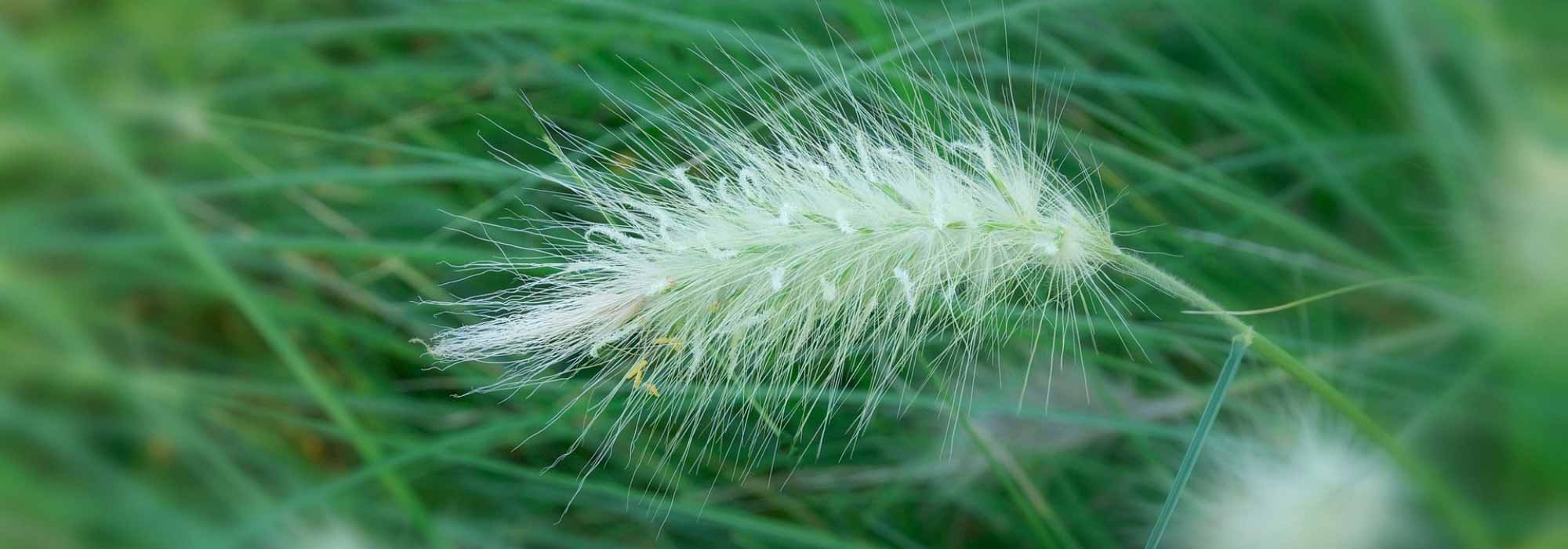
Pennisetum - Fountain grass : planting, pruning, care
Contents
Pennisetum in a nutshell
- Pennisetum is distinguished by its attractive flowering in the form of fluffy bottlebrushes
- Its fine foliage, with an infinite lightness, remains graphic even when dry throughout the bad season
- It is a hardy grass, often very hardy, tolerant of soil, sea spray, and drought
- Once well-rooted in light, well-drained soil, it requires almost no maintenance
- Versatile, Pennisetum is essential in borders, rockeries, and also in flowering pots
A word from our expert
Pennisetum is a trendy grass also known as “Fountain Grass” due to the cylindrical shape of its fluffy spikes. It is widely used by landscapers to bring movement, naturalness, and light to the garden.
This robust perennial plant is often very hardy and is sought after for the beauty of its summer or autumn flowering that dominates the moving mass of fine foliage that remains graphic throughout the harsh season. The spectacle continues even in winter when a white frost or hoarfrost covers the culms.
Its quivering silhouette in a light mass that undulates at the slightest breeze and then becomes sumptuous when covered in frost is essential for adding a wild yet structured aspect to all gardens, whether more naturalistic or contemporary.
Whether it is Pennisetum alopecuroides, Pennisetum orientale, or Pennisetum setaceum, “Fountain Grass” is an easy-to-maintain grass accessible to all beginner gardeners. With great ease of cultivation, it is not demanding regarding soil, perfectly adapted to sea spray and drought, it stands out in borders, in rockeries, along path edges, but also in flower pots.
Choose from our unique collection your Pennisetum or “Fountain Grass”, this original grass that has become very popular in recent years in all dry gardens!

Play of light in the inflorescences of a Pennisetum
Description and Botany
Botanical data
- Latin name Pennisetum
- Family Poaceae
- Common name Pennisetum, Bottlebrush Grass
- Flowering June to December
- Height 0.15 to 1.80 m
- Sun exposure Sun, partial shade
- Soil type All, well-drained
- Hardiness -5°C to -25°C
The genus Pennisetum comprises around 80 species of annual or perennial grasses from the Poaceae family, native to the forests and savannas of tropical and warm temperate regions, particularly in Africa and Asia.
Commonly referred to as “Bottlebrush Grass” and known as “Fountain Grass” in English, its name comes from Latin, meaning “feather” and “silk,” in reference to its fluffy spike inflorescences resembling small bottle brushes.
Although perennial and hardy in most of our climates, some more tender species are grown as annuals in cooler climates. Pennisetum alopecuroides is the most widespread species in our gardens, being the hardiest (-25°C) and the only one that can tolerate the most varied growing conditions. It comes in numerous cultivars such as ‘Little Bunny’.
Also encountered is Pennisetum incomptum, which is very hardy and tolerant of soil, salt spray, and drought, making it a good choice for landscaping difficult areas and dry slopes.
Often grown as an annual or in pots, Pennisetum villosum and Pennisetum setaceum are hardy down to -5 to -10°C in good light, well-drained garden soil. With a height of 1.80 m, Pennisetum macrourum is one of the tallest in the genus and is better suited for large spaces.
It is a tufted grass that does not spread through its roots: all stems arise from the stump. Non-invasive, it forms a very compact stump with a bushy appearance that will reach 0.15 m to 1.80 m in height when in flower, with almost the same diameter at the base. Some species, such as Pennisetum setaceum, can become invasive in mild climates and are now banned from sale as they are considered invasive and difficult to control.

Pennisetum features inflorescences of various shapes and colours: Pennisetum alopecuroides ‘Karley Rose’, Pennisetum macrourum, Pennisetum alopecuroides ‘Moudry’, Pennisetum orientale ‘Tall Tails’, Pennisetum setaceum ‘Rubrum’.
Pennisetum or “Bottlebrush Grass” forms a erect and arching tuft with a somewhat loose, more or less spreading habit, very flexible and dense at the same time.
The deciduous or evergreen foliage in warm regions forms a fountain of very fine, linear leaves that are drooping, rough, and somewhat sharp, either flat or ribbon-like. Ranging from 8 to 60 cm in length, they are light green to dark green, sometimes variegated with green, pink, and purple-red (‘Rubrum’). The foliage is often marcescent, drying but persisting in winter, taking on a beautiful straw-yellow hue or vibrant red and orange highlights in autumn.
From this gramineous vegetation, floriferous culms rise proudly in summer or autumn, from June to December, depending on the species and varieties. Pennisetum produces long silky spikelets measuring 8 to 40 cm grouped in feathery panicles, cylindrical or nearly spherical that sometimes droop under their own weight. These characteristic inflorescences gathered in bottlebrush-like clusters covered with long, very soft hairs inevitably evoke bottle brushes, hence its nickname, large silky caterpillars, or even the fluffy tail of a rabbit.

Some varieties offer decorative foliage and beautiful autumn colours: Pennisetum setaceum ‘Skyrocket’, Pennisetum setaceum ‘Rubrum’, Pennisetum alopecuroides ‘Hameln Gold’, Pennisetum alopecuroides ‘Hameln’, Pennisetum setaceum ‘Fireworks’.
These fluffy spikes of cream to silver, spring green-white then pale brown to purple at maturity, bronze yellow, brown-black (Pennisetum alopecuroides ‘Moudry’), beige-pink, or even purple-pink (Pennisetum orientale ‘Karley Rose’) are sometimes topped with a white tuft (Pennisetum alopecuroides ‘Japonicum’), enhanced by morning dew.
Once faded, these light spikes remain elegant throughout the harsh season, drying in autumn to shades of bleached blonde and becoming frosted in winter. They are perfect for fresh or dried bouquets.
The Pennisetum is a very easy-to-cultivate perennial grass, undemanding, frugal and hardy (sometimes down to -25°C in well-drained soil) practically everywhere in France. Less hardy Pennisetum will often be grown as annuals in summer beds or pots.
It enjoys warm and sunny exposures and prefers dry, light, and well-drained soils, not too heavy. It tolerates salt spray from seaside gardens very well.
Essential and versatile, Pennisetum can be planted in a rockery, a border, in a scree garden, a wild or contemporary garden, where it adds lightness and movement with its clean and elegant appearance. It also stands out in flower pots. Some species can also be used as ground cover or to stabilise a dry slope.
Main species and varieties
Le pennisetum is a very trendy grass that includes numerous species and varieties, most of which are hardy like Pennisetum alopecuroides, P. incomptum (-25°C). Some pennisetums, such as P. setaceum and its hybrids and P. villosum, are not hardy at all (-5°C to -10°C) and are most often used as annual plants in summer pots, like Pennisetum setaceum ‘Rubrum’, the most well-known of the annual pennisetums.
While Pennisetum alopecuroides has a good tendency to self-seed without ever being invasive, Pennisetum setaceum, deemed invasive, has recently been subject to an ban on introducing, cultivating, selling, or using it. However, its cultivars are not affected.
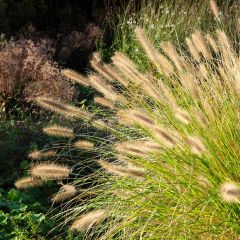
Pennisetum alopecuroides Hameln - Chinese Fountain Grass
- Flowering time October, November
- Height at maturity 50 cm
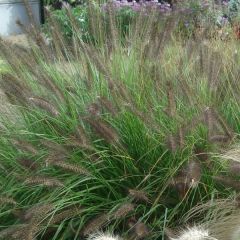
Pennisetum alopecuroïdes Moudry - Chinese Fountain Grass
- Flowering time September to November
- Height at maturity 80 cm
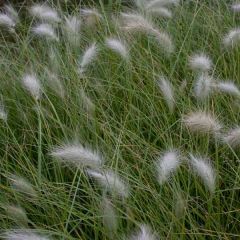
Pennisetum villosum
- Flowering time September to November
- Height at maturity 70 cm
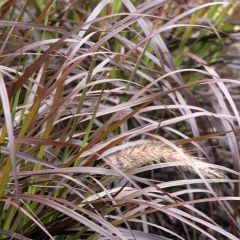
Pennisetum advena Rubrum - Purple Fountain Grass
- Flowering time August to November
- Height at maturity 1 m
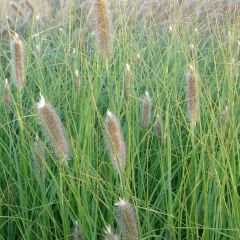
Pennisetum alopecuroïdes Japonicum - Chinese Fountain Grass
- Flowering time September to November
- Height at maturity 1,50 m
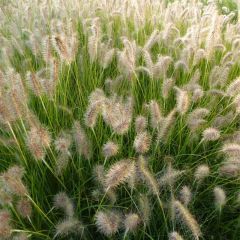
Pennisetum alopecuroides Goldstrich - Chinese Fountain Grass
- Flowering time August to November
- Height at maturity 60 cm
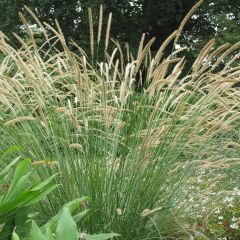
Pennisetum macrourum - African feather Grass
- Flowering time September to December
- Height at maturity 1,80 m
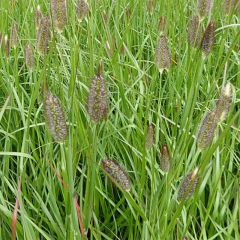
Pennisetum massaicum Red Bunny Tail - African feather Grass
- Flowering time August to October
- Height at maturity 80 cm
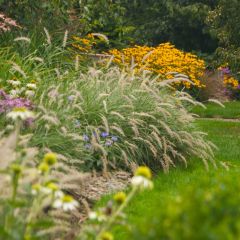
Pennisetum orientale Shogun - Oriental Fountain Grass
- Flowering time August to November
- Height at maturity 90 cm
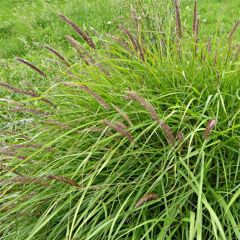
Pennisetum incomptum
- Flowering time July to November
- Height at maturity 1,10 m
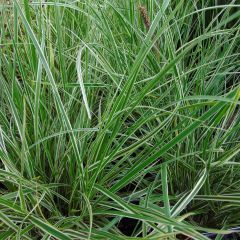
Pennisetum setaceum Skyrocket
- Flowering time August to November
- Height at maturity 80 cm
Discover other Pennisetum
View all →Available in 0 sizes
Available in 3 sizes
Available in 2 sizes
Available in 3 sizes
Available in 2 sizes
Available in 6 sizes
Available in 1 sizes
Available in 2 sizes
Available in 3 sizes
Available in 2 sizes
Planting
Where to Plant Pennisetum or “Fountain Grass”
The Pennisetum is a robust and hardy grass in most of our regions. While Pennisetum alopecuroides is the most resilient of all (it withstands -25 °C in well-drained soil), the growth of some species can be more sensitive, and some, like P. villosum and P. setaceum, will be grown as annuals or in pots that need protection from the cold in climates with harsh winters.
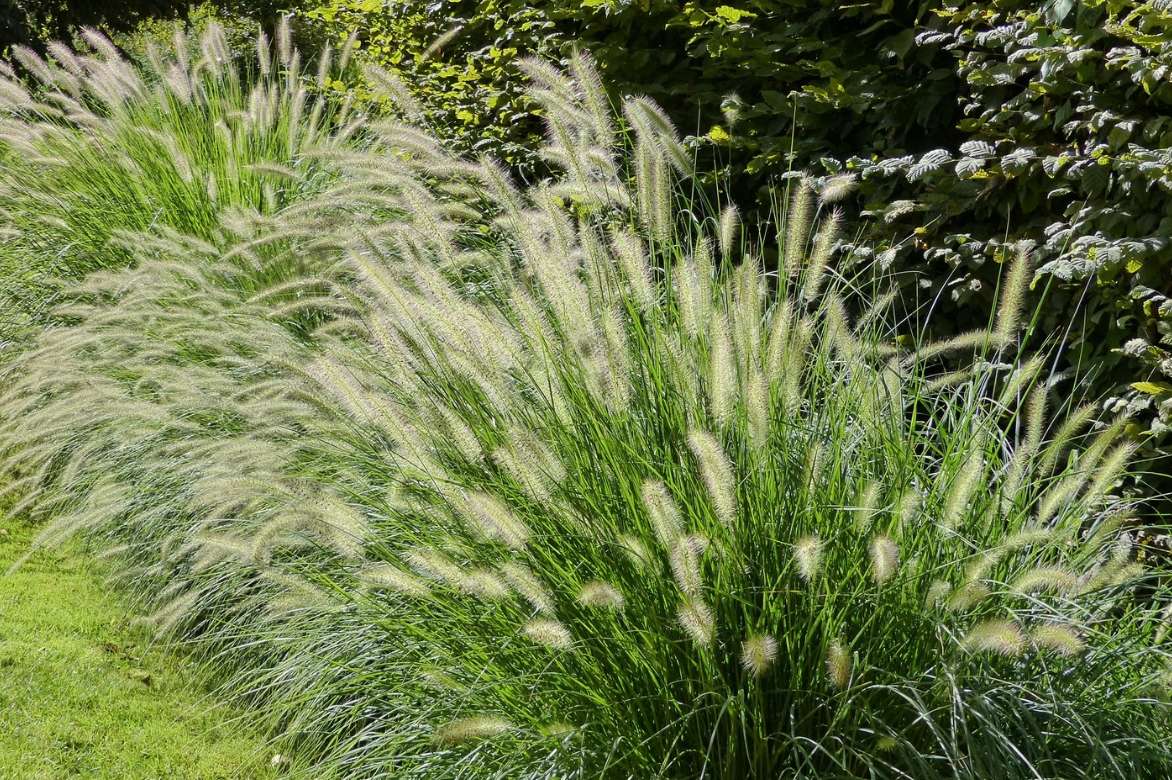
Border of Pennisetum alopecuroides
It is drought-resistant and is not afraid of salt spray or wind. With its coastal character, a seaside garden exposed to salt spray will suit it perfectly.
It particularly enjoys full sun, or possibly partial shade in hot climates, a well-exposed location, and its undemanding nature appreciates dry, light, very well-drained soils, even sandy or calcareous ones. Not being a demanding perennial, Pennisetum will be content with almost all types of soil except for overly heavy and moisture-retaining soils that suffocate its roots.
With its graphic and airy silhouette, it stands out in all soft and wild gardens, in a flowering meadow, in a dry or gravel garden, as well as in the most contemporary spaces where it highlights all perspectives, even in the smallest of gardens: this non-invasive plant, with a tufted habit, forms a beautiful clump that is always impeccable and does not spread.
Its fluffy spikes and infinitely light foliage integrate into all settings, on slopes, in a large dry rockery, in sun-baked borders, around entrances, always bringing breath, movement, and delicacy.
The tallest varieties are planted in the middle or back of borders, giving them a fluffy and shimmering relief, while the shorter varieties can be placed at the edge of paths, in pots or planters on the terrace, or serve as an excellent ground cover solution for landscaping difficult areas, to hold a dry slope: the Pennisetum has the advantage of limiting erosion thanks to its very dense root system.
When to Plant Pennisetum or “Fountain Grass”
Planting Pennisetum can be done in spring from March to June or in autumn in September-October, avoiding periods of severe frost or extreme heat.
How to Plant Pennisetum or “Fountain Grass”
In the Ground
To achieve a beautiful effect quickly in a border, plant at least 5 to 7 plants per m². You can also plant it in mass, in tight rows (every 30 to 40 cm) to create a low hedge or a light path border.
If your soil is heavy, add a handful of gravel, a bit of potting soil, or even some river sand: Pennisetum loves light and well-drained soils.
- Plant Pennisetum in a planting hole 20 cm in diameter
- Loosen the extracted soil well
- In heavy or very wet soil, spread a layer of gravel at the bottom of the hole
- Do not plant too deeply
- Place the young plant in the middle of the hole, covering the root ball with 3 cm of soil. Firm and water generously
- Water if necessary once or twice every 15 days to aid establishment
Planting Pennisetum in a Pot
- Improve drainage with gravel, coarse sand, or a mix of pebbles
- In a large terracotta pot of at least 50 cm in diameter, spread the drainage layer
- Plant in a mix of light soil enriched with a bit of potting soil and coarse river sand
- Water at planting and then regularly.
- Place your pot in full sun.
→ Learn more about planting Pennisetum in pots in our advice sheet!

Pennisetum is well-suited for pot cultivation. Here, the Pennisetum alopecuroides ‘Hameln Gold’ with bright foliage.
Read also
Grasses: which variety to choose?Pruning and care
Once well established, Pennisetum requires little maintenance. It is the ideal plant for weekend gardens! Once well rooted, it will be fairly drought-resistant: however, water during periods of intense heat or prolonged dry weather, as it appreciates relatively cool soil in summer.
In regions with very cold winters, spread a plant mulch (flax pale, dry leaves…) around the stump to protect the plant from frost.
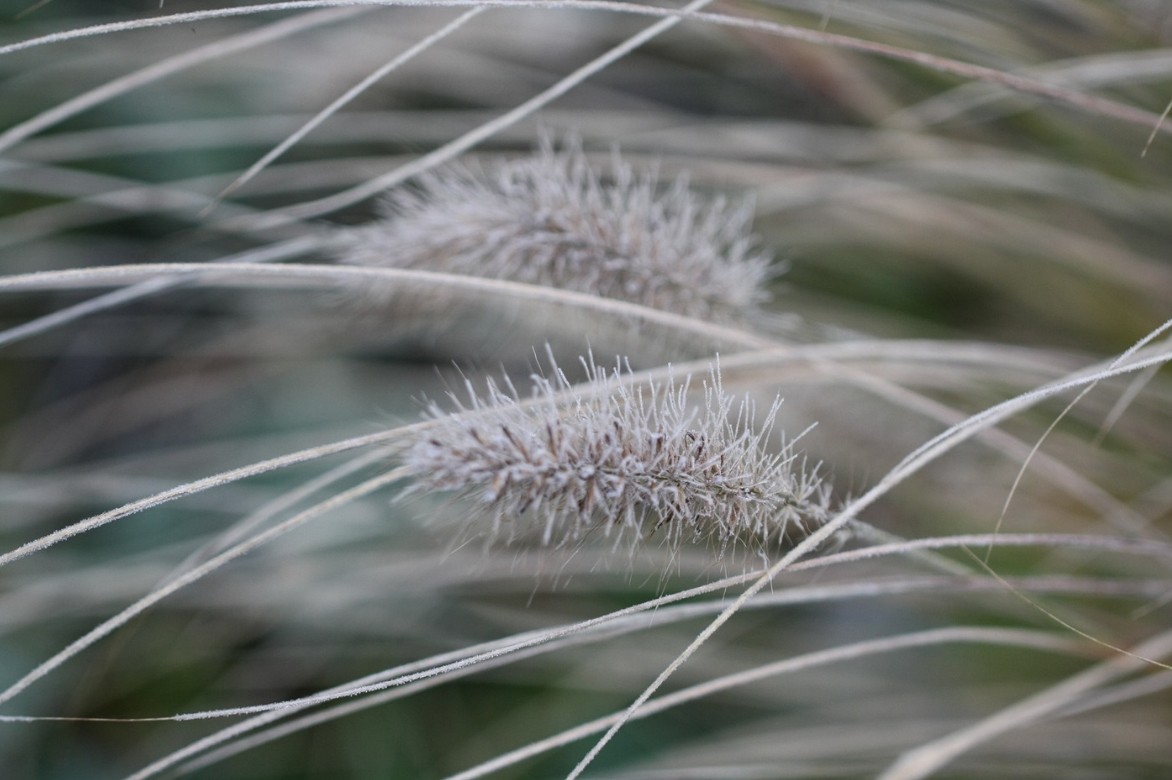
Frost enhances the inflorescences of Pennisetums.
In poor soils, consider adding a handful of well-matured compost in spring. Pennisetum in pots will appreciate some organic fertiliser once a year at the end of winter.
Leave the faded inflorescences standing: in winter, they will be revealed under the frost.
In February-March, simply cut back the dried culms to 10 cm above the soil using shears to make way for new foliage.
→ Learn more about Pennisetum pruning: when and how? with our tutorial!

At the end of winter, cut back the clumps of Pennisetum
In well-drained soil, Pennisetum is insensitive to diseases.
Dividing clumps of Pennisetum
The division of clumps of Pennisetum in spring remains the simplest method. It is carried out when the plant is well-rooted, after 3 to 4 years of cultivation. In mild climates, some species self-seed spontaneously.
- From March, using a forked spade, gently lift the clump
- Insert two spades back to back in the middle and lift one using leverage
- Take a few vigorous pieces
- Replant the pieces immediately in well-prepared soil
- Water generously
Pairing Pennisetum
The play of light through and within the foliage, the infinite lightness of the leaves, the delicate grace of the spikelets, with their wildflower charm, the flowers of Pennisetum swaying at the slightest breeze, suit all gardens, large or small, urban, rural or coastal.
Versatile, this vigorous grass will be stunning in a wild garden, in the clean and elegant scenes of a contemporary garden and graphic, in a dry or gravel garden, adding a quivering poetry to naturalistic meadows or beds with other summer-flowering perennials, among the stones of a large rockery, as ground cover or mixed in a colourful mixed border, planted en masse along a path, or in flowering pots.
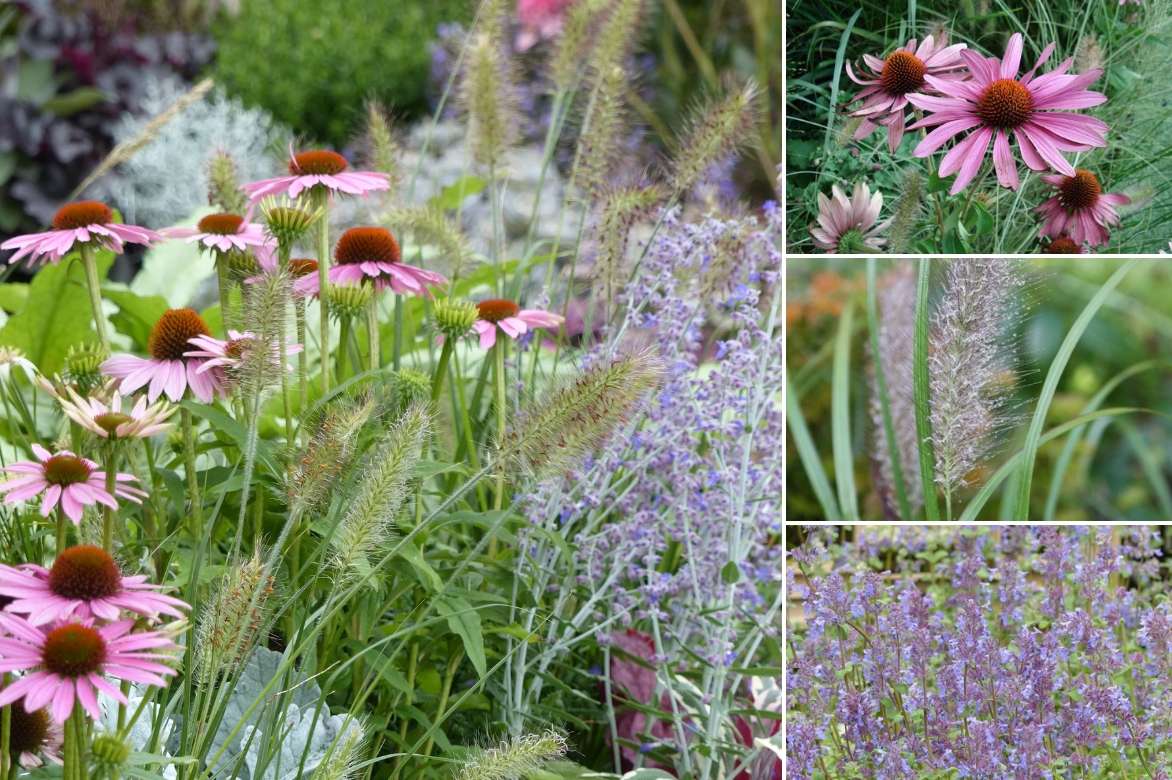
A natural association idea: Pennisetum alopecuroides ‘Hameln’, Echinacea purpurea and Nepeta faassenii ‘Six Hill’s Giant’.
Airy, it brings a lot of softness, lightness, and movement to all settings, transparently highlighting all perspectives and adding a vibrant and poetic touch to the heart of summer.
Easy to combine, its elegant foliage tempers bright colours and serves as a backdrop for many perennials to which it brings light, breath, and volume.
In a lush bed with a country spirit, pair it with wandering plants, lavenders, yarrow, gaura and eupatoriums or with tall perennials like sages or Verbena bonariensis. It will soften the somewhat stiff habit of dahlias, large thistles, tritomas or perovskias.
For breathtaking scenes of finesse and lightness, Pennisetum will be associated with the golden spikes of grasses like Calamagrostis brachytricha or Diamond Grass, and tufted canary grass.
In a mixed border, it will bring a lot of flexibility to the sunny flowers of coreopsis, Echinaceas or heleniums.
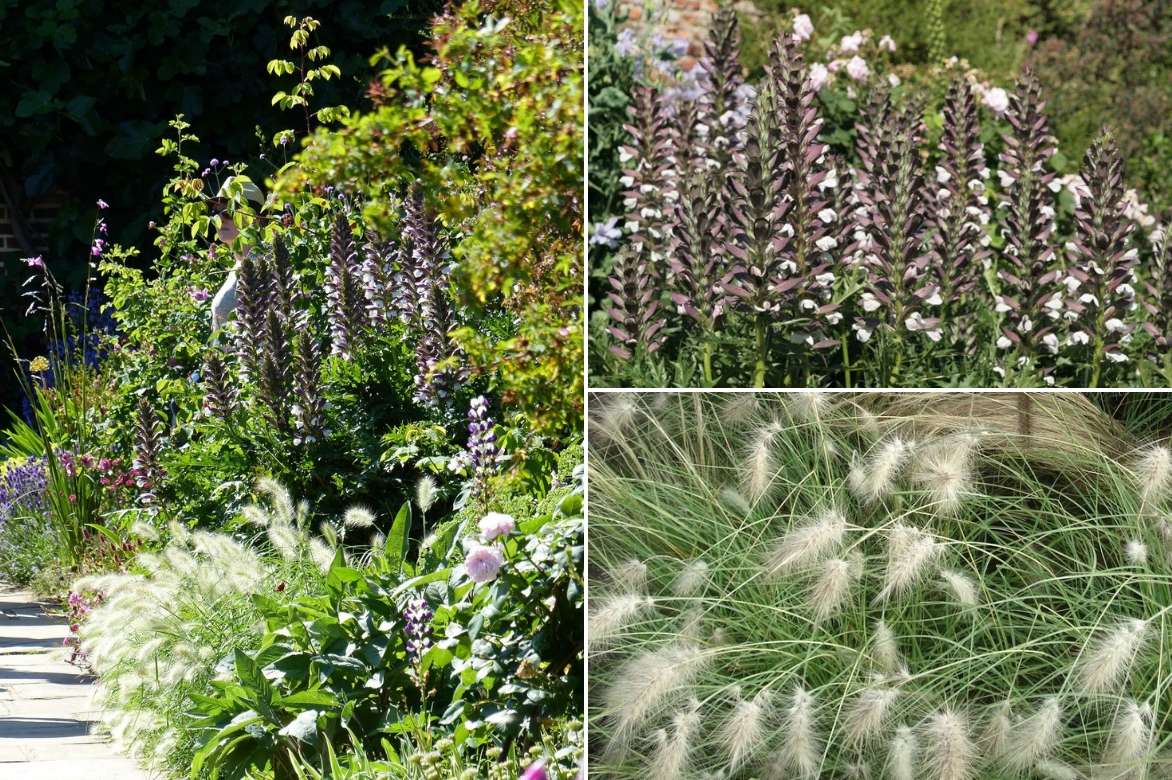
An association idea: Pennisetum villosum and Acanthus spinosus.
In a more modern style, combine the fountain grass with other grasses, large wild grasses like Miscanthus, pampas grass, with Allium, and knotweeds. It is widely used in front gardens, close to the house, in modern mineral-style beds, surrounded by pebbles or white gravel and two or three box balls.
At the edge of a path, pair it with perennials with summer or autumn flowering like hybrid mulleins, autumn daisies, hardy chrysanthemums, Virginia veronicas, shrub sages, with shrub heathers, and asters.
In a rockery, the fountain grass will be perfect when paired with autumn sedums.
A screen of dark, evergreen foliage (dwarf conifers, laurel-tin, oleaster) will beautifully highlight its white, cottony inflorescences.
In a white garden, it can be associated with hydrangeas, dwarf roses, epilobiums, sanguisorbas, Japanese anemones, sea cinereas, tree wormwoods or silver-leaved buddleias (‘Silver Anniversary’).
In a planter, it can mix in a frenzy of colours with frost-sensitive or annual flowers like petunias, begonias or with cosmos, nigellas, osteospermums and lantanas.
Useful resources
- Discover our tutorial to find out how to divide Pennisetum
- Incorporate grasses into a naturalistic meadow!
- Graphical and airy, our grasses are essential for creating contemporary scenes
- Design a graphic garden by focusing on Pennisetum!
- Get inspired with all our tips on grasses
- Discover Christine’s article on plume inflorescences
- Discover 5 grasses with variegated foliage
- Pennisetum: the best varieties for pots
- Subscribe!
- Contents
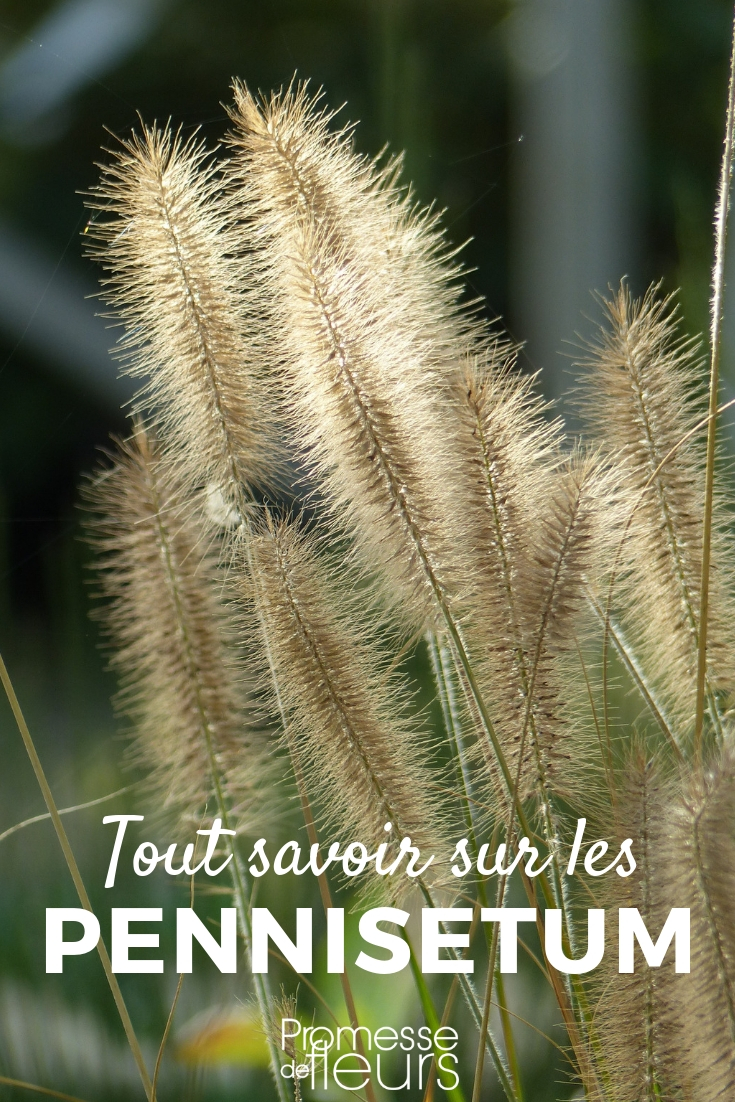































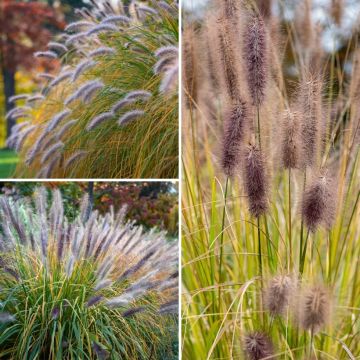

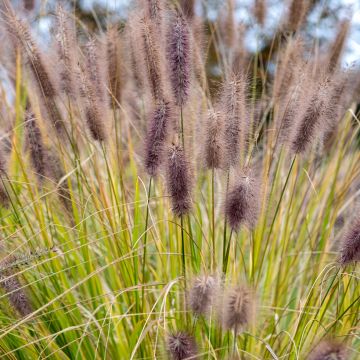
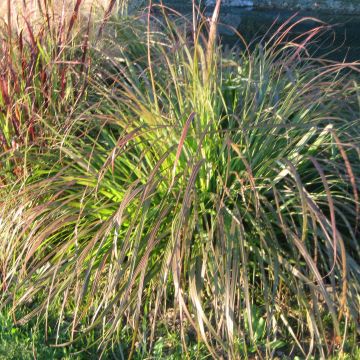


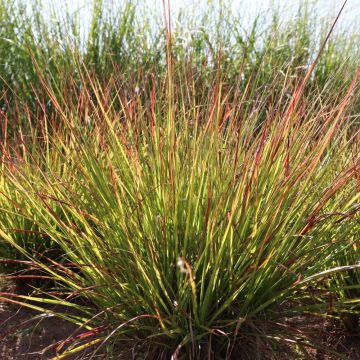
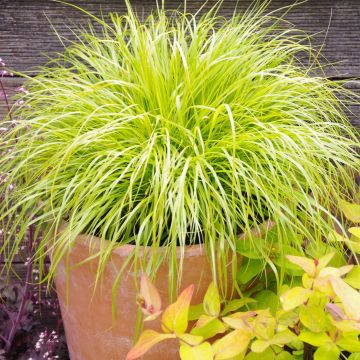
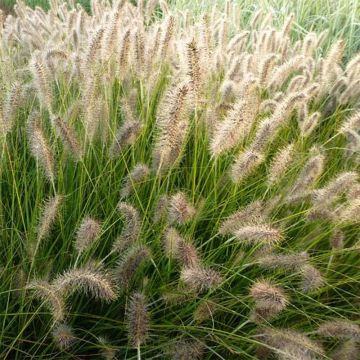
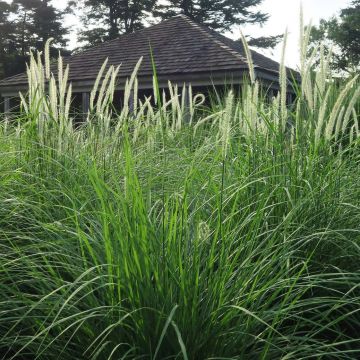
Comments